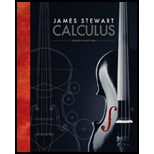
Concept explainers
Show that
To show:
Answer to Problem 1P
Solution:
Explanation of Solution
1) Concept:
Use Closed Interval Method to find the absolute maximum and absolute minimum values for the given function.
2) The Closed Interval Method:
To find the absolute maximum and minimum values of a continuous function
i) Find the values of
ii) Find the values of
iii) The largest of the values from the above steps is the absolute maximum value and the smallest of these values is the absolute minimum value.
3) Formula:
4) Calculation:
To show that
Using formula, above equation becomes
Now, let
The function
Take derivative of
Simplify.
To find critical numbers, equate
Subtract
Simplify.
Divide by
This is only true when,
Therefore, critical numbers are
To find the absolute maximum and minimum values
substitute critical numbers and endpoints in the function
Substitute.
Simplify.
Substitute.
Simplify.
Substitute,
Simplify.
Substitute.
Simplify.
By Closed Interval Method,
Therefore,
Therefore,
Conclusion:
Therefore,
Want to see more full solutions like this?
Chapter 3 Solutions
Calculus (MindTap Course List)
Additional Math Textbook Solutions
Math in Our World
Calculus: Early Transcendentals (2nd Edition)
Precalculus: A Unit Circle Approach (3rd Edition)
Elementary Statistics
Elementary Statistics (13th Edition)
Mathematics for the Trades: A Guided Approach (11th Edition) (What's New in Trade Math)
- Can you help explain what I did based on partial fractions decomposition?arrow_forwardSuppose that a particle moves along a straight line with velocity v (t) = 62t, where 0 < t <3 (v(t) in meters per second, t in seconds). Find the displacement d (t) at time t and the displacement up to t = 3. d(t) ds = ["v (s) da = { The displacement up to t = 3 is d(3)- meters.arrow_forwardLet f (x) = x², a 3, and b = = 4. Answer exactly. a. Find the average value fave of f between a and b. fave b. Find a point c where f (c) = fave. Enter only one of the possible values for c. c=arrow_forward
- please do Q3arrow_forwardUse the properties of logarithms, given that In(2) = 0.6931 and In(3) = 1.0986, to approximate the logarithm. Use a calculator to confirm your approximations. (Round your answers to four decimal places.) (a) In(0.75) (b) In(24) (c) In(18) 1 (d) In ≈ 2 72arrow_forwardFind the indefinite integral. (Remember the constant of integration.) √tan(8x) tan(8x) sec²(8x) dxarrow_forward
- Find the indefinite integral by making a change of variables. (Remember the constant of integration.) √(x+4) 4)√6-x dxarrow_forwarda -> f(x) = f(x) = [x] show that whether f is continuous function or not(by using theorem) Muslim_mathsarrow_forwardUse Green's Theorem to evaluate F. dr, where F = (√+4y, 2x + √√) and C consists of the arc of the curve y = 4x - x² from (0,0) to (4,0) and the line segment from (4,0) to (0,0).arrow_forward
- Evaluate F. dr where F(x, y, z) = (2yz cos(xyz), 2xzcos(xyz), 2xy cos(xyz)) and C is the line π 1 1 segment starting at the point (8, ' and ending at the point (3, 2 3'6arrow_forwardCan you help me find the result of an integral + a 炉[メをメ +炉なarrow_forward2 a Can you help me find the result of an integral a 아 x² dxarrow_forward
- Algebra & Trigonometry with Analytic GeometryAlgebraISBN:9781133382119Author:SwokowskiPublisher:Cengage
